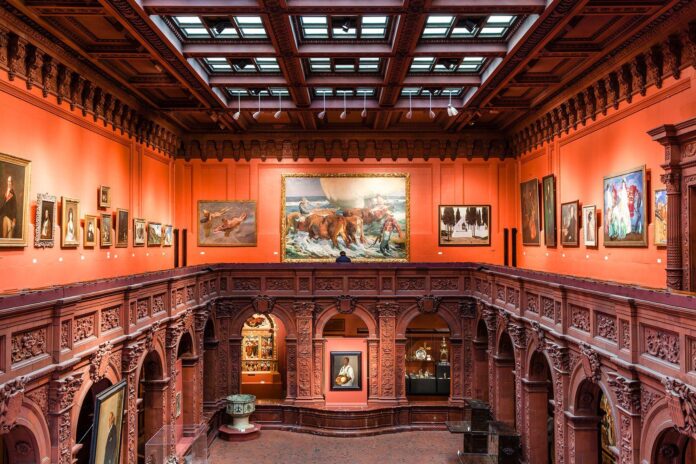The Hispanic Society Museum & Library in Upper Manhattan—one of the great repositories of art and culture from Spanish- and Portuguese-speaking countries—is reopening the doors of its Main Building, closed since 2017, on 30 March with the completion of $20m in infrastructural improvements.
The Spanish Renaissance-style Main Court, with its spectacular terracotta arcade, and the gallery dedicated to Joaquín Sorolla’s panoramic paintings cycle, Vision of Spain, originally installed in 1926, are disability accessible for the first time. The building has been refurbished with upgraded roofing, electrics, pipes, painting, lighting and signage.
“We wanted to keep the magic of the dear spaces people have been missing but make them less dusty, more dynamic, more welcoming and less of a secret,” says CEO and director Guillaume Kientz, who joined the museum in 2021 while the work, carried out by Selldorf Architects and Beyer Blinder Belle Architects, was under way.
With a jewel-box collection of 750,000 objects, including masterpieces by El Greco, Velázquez and Goya, the Hispanic Society, founded in 1904 by the collector and philanthropist Archer Huntington, has long been a beloved pilgrimage spot for researchers and specialists.
But its century-old neoclassical buildings—on a block-large campus also including Boricua College and the American Academy of Arts and Letters, and cut off from Manhattan’s Broadway by iron gates—did not do a good job of inviting people in. New banners on the façade and signage on the gates, negotiated with the Landmarks Preservation Commission, aim to help address this branding problem.
“This museum should engage with the local community, New Yorkers at large and tourists visiting the city. It should make them feel a part of the museum community,” Kientz says. “The idea is to become a destination. But we want to also ensure the place is hanging new works all the time, with new displays in the Main Court every six months and in the project gallery every three months.”
Shortly after his arrival, Kientz partnered with the Northern Manhattan Arts Alliance (NoMAA) to install four murals by living artists, retracing the story of immigration of the Latinx community in upper Manhattan, on the Broadway Terrace just inside the gates between 155th and 156th streets. He watched people come in every day and take selfies. “I realised that this is an amazing stage,” says Kientz. “It is our most immediate driver to convince people to pass through the gate.”
Vibrating light and colour
This spring, on the upper Audubon Terrace, the museum will install a bright yellow artwork titled Penetrable (1990) by the Venezuelan Jesús Rafael Soto, on loan from the Colección Patricia Phelps de Cisneros. The work is designed to celebrate the centennial of the birth of this pioneering kinetic artist. It is the first time one of Soto’s large-scale interactive cubes, composed of a grid of dangling tubes that viewers can walk through to experience a maze of vibrating light and colour, will be shown in New York.
Other wall works by Soto on loan will be hung inside the Main Court, in juxtaposition with a selection of atmospheric seascapes and portraits from the Hispanic Society’s extensive collection of Sorolla, considered the hottest painter in Spain at the turn of the 20th century and who died the year of Soto’s birth. “It’s an unexpected encounter between two artists from different universes and aesthetics,” Kientz says. “We’re going to play with this contrast in this very public setting.”
Inside the reopened permanent Sorolla Gallery, the Spanish jewellery designer Luz Camino will have her first museum exhibition in the US. It will provide another lively conversation between artists across time who share an interest in vibrant colour and the manipulation of light.
In June, the Hispanic Society will again activate the Broadway Terrace with a large-scale installation by the Argentinian-born artist Marta Chilindron, whose Orange Cube (2014) consists of 62 brightly coloured, hinged square panels that can be unfolded in multiple configurations. Chilindron is the first winner of an open call to residents of upper Manhattan for an annual summer installation, another partnership with NoMAA.
The next phase of the masterplan is anticipated to begin in 2024 on the East Building. The continued renovation will include a visitor centre, special exhibition galleries, an education centre and a conservation lab, to be connected internally to the Main Building. The four-year project has a budget of $50m, two-thirds of which has been raised—led by the efforts of the board chair Philippe de Montebello, former long-time director of New York’s Metropolitan Museum of Art. “He’s the main ambassador of the Hispanic Society,” says Kientze “It’s been great to have him as a chair and a mentor.

























